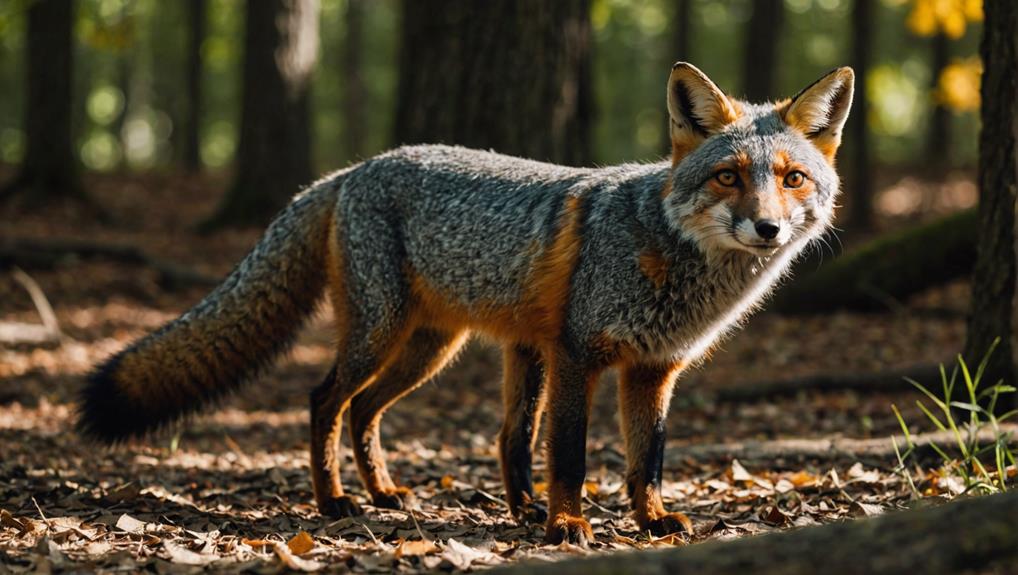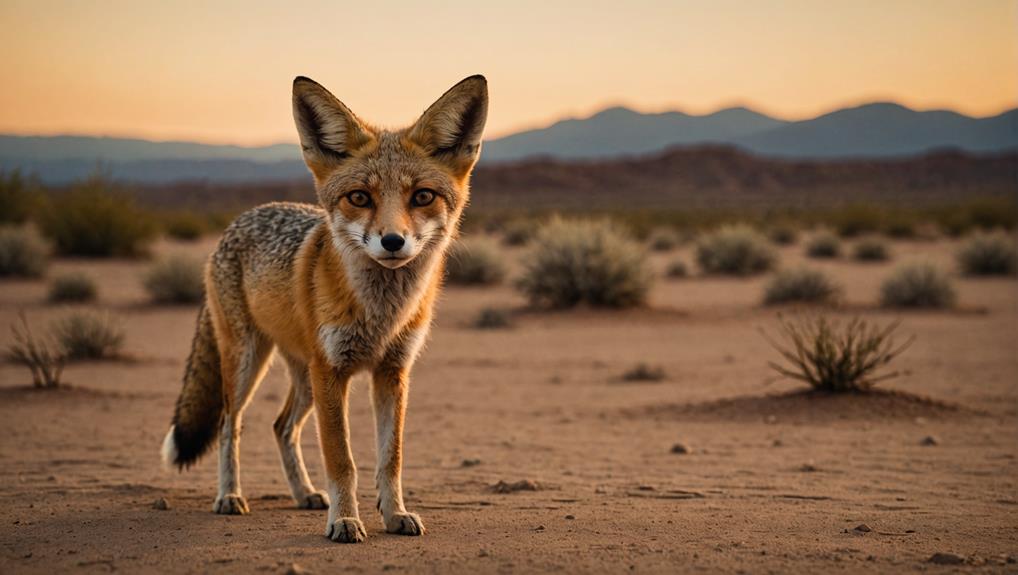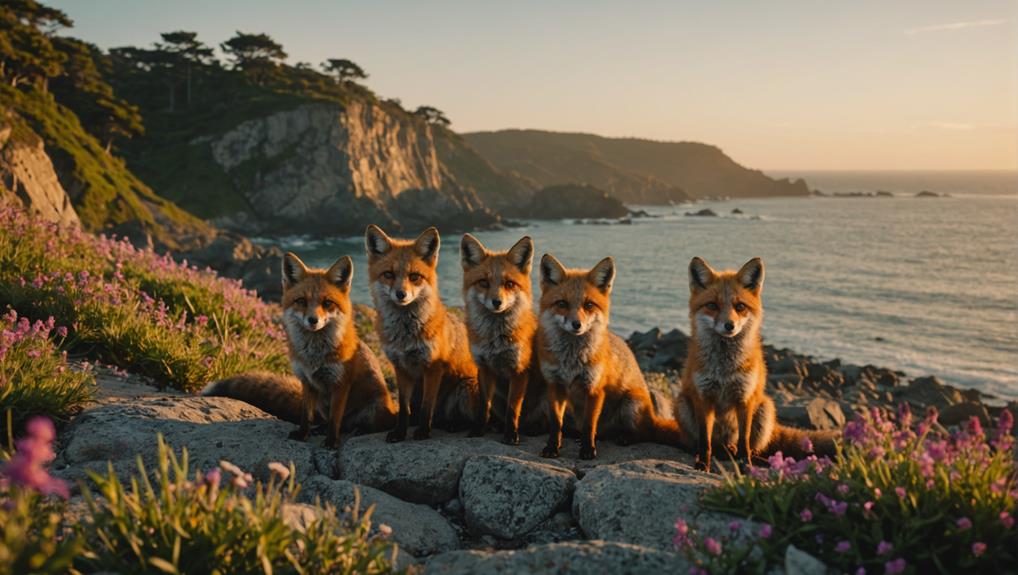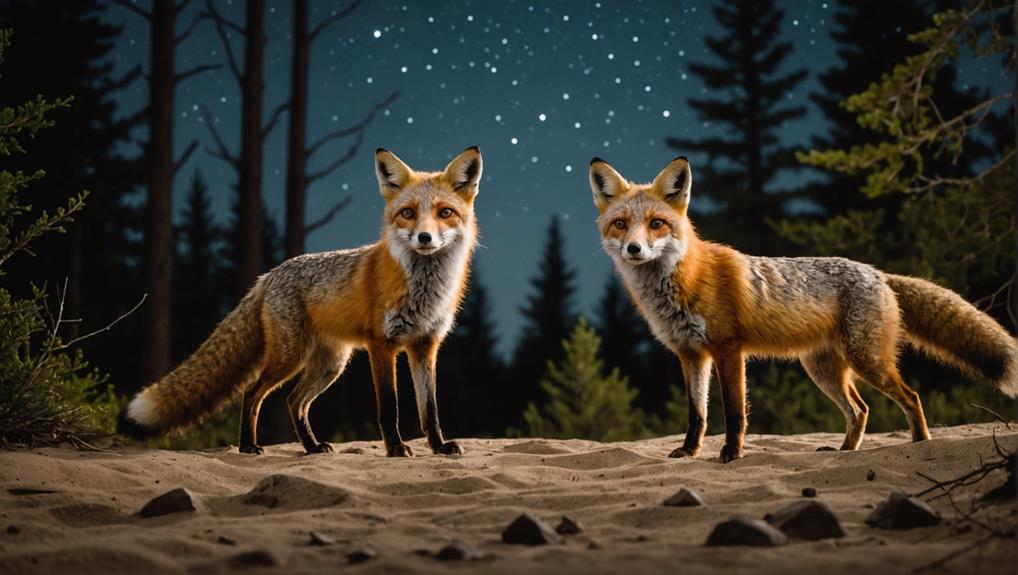When you think of foxes in North America, picture four main players: the Red Fox, Gray Fox, Arctic Fox, and Kit Fox. The Red Fox, with its fiery fur, is the most famous and adaptable. The Gray Fox, a crafty climber, loves wooded areas. Over in the chilly tundra, you'll find the Arctic Fox, sporting a seasonal fur coat for style and survival. Don't forget the adorable Kit Fox, the smallest of the bunch, thriving in dry deserts. Each one has its own quirky charm, and there's more to discover about their lives and habitats if you stick around!
Contents
North American Fox Species
When exploring the diverse wildlife of North America, you can't overlook the fascinating fox species that call this continent home. Four primary foxes inhabit the region: the Red Fox, Gray Fox, Arctic Fox, and Kit Fox. Each one adds its own unique charm to our ecosystems.
The Red Fox is the most widespread, easily recognizable with its striking orange-red coat and white-tipped tail. It thrives in various habitats across the continent, except Florida, where it obviously decided to skip out on the sunshine! With approximately 47 recognized subspecies, the Red Fox has adapted to an array of environments, showcasing remarkable adaptability.
Next, you have the Gray Fox, a master climber who prefers wooded areas. Weighing between 7-13 pounds, this clever critter can escape predators by scaling trees. Talk about a great escape!
In addition to its climbing prowess, the Gray Fox plays a vital role in regulating populations of small mammals and birds, contributing to ecosystem balance its role in ecosystems.
In the chilly tundra, the Arctic Fox is perfectly adapted, changing its fur color with the seasons. It weighs around 15 pounds and relies on scavenging when food gets scarce in winter—definitely a survivor!
Red Fox Overview
The Red Fox (Vulpes fulva) stands out as the most common and recognizable fox species in North America. With its striking orange-red fur, it's hard not to admire these beautiful creatures! You might find their bushy tails and black legs equally charming.
Diverse ecosystems provide ample food sources for red foxes, enhancing their adaptability to various environments. Here are a few fun facts:
- They weigh between 8 to 15 pounds.
- Red Foxes are highly adaptable and can thrive in various habitats.
- Their mating season kicks off in late January!
These North American foxes are solitary hunters, typically prowling for small mammals, birds, and even insects. You might be surprised to learn that they can also scavenge for fruits when food gets scarce.
Their ability to adapt to urban areas makes them quite the survivors!
When it's time to mate, they usually produce around four kits, born in March or April, who quickly learn to fend for themselves. Isn't nature fascinating? Whether you're spotting a Red Fox in your backyard or reading about them, there's always something new to discover about these remarkable foxes in North America.
Gray Fox Characteristics

When you think about Gray Foxes, picture their stunning salt-and-pepper fur with those rusty yellow accents—it's like nature's own fashion statement!
These clever critters prefer wooded areas, where they can climb trees to escape danger, showing off their unique skills.
Plus, as nocturnal hunters, they rely on their senses to find food, making them fascinating creatures to learn about.
Habitat Preferences
Gray foxes thrive in a variety of habitats, with a strong preference for dense woodlands, scrublands, and even urban areas. You might be surprised to learn how adaptable these clever creatures can be!
Here's what makes them special:
- They love climbing trees, giving them an edge over predators.
- Unlike red foxes, gray foxes prefer rugged terrains and shy away from extreme cold.
- They often find cozy spots in suburban neighborhoods, where food is plentiful.
These foxes are solitary hunters, making their homes in areas that provide cover for stalking prey. Their adaptability allows them to coexist with humans, often venturing into urban areas where they can scavenge for food.
You may spot them rummaging through gardens or darting across streets at dusk.
Home ranges for gray foxes can vary from 1 to 4 square miles, depending on food availability and habitat quality.
Physical Appearance
With a striking appearance, the Gray Fox (Urocyon cinereoargenteus) boasts salt-and-pepper gray fur accented by rusty yellow tones on its underside and legs. Weighing between 7 to 13 pounds, this fox is slightly smaller than its cousin, the Red Fox, and measures about 32 to 45 inches long. Its bushy tail, featuring a distinctive black stripe along the top, makes it stand out in the wild.
You might find it fascinating that the Gray Fox is one of the few wild animals capable of climbing trees! This unique ability helps them escape predators and navigate their forested habitats. Just picture a fox nimbly scaling branches—it's quite an impressive sight!
The Gray Fox's large, rounded ears and slender muzzle enhance its hearing and scenting skills, which are essential for hunting small mammals and birds.
When you see a Gray Fox in action, you can appreciate how its physical traits perfectly equip it for survival. So, whether you're a wildlife enthusiast or just curious about these creatures, knowing about their striking features helps you appreciate the beauty and diversity of foxes in North America.
Behavior and Diet
Adaptable and resourceful, the Gray Fox (Urocyon cinereoargenteus) thrives in varied environments thanks to its diverse diet and unique hunting strategies.
You'll find these clever creatures mostly hunting alone or in small family groups, showcasing their solitary behavior. They're primarily nocturnal, so expect them to be more active at night, although you might catch a glimpse of them foraging during the day when it's quieter.
Here are a few fun facts about their diet and behavior:
- They love a variety of foods, including small mammals, birds, and fruits.
- Rodents and rabbits make up a significant portion of their meals.
- Their stealthy approach and cunning hunting tactics help them thrive in different habitats.
Gray Foxes aren't just about the hunt; they communicate with a range of sounds, like barks and howls, especially during mating season.
This social interaction brings them together, even if they prefer to roam solo most of the time. Their adaptability and resourcefulness make them a fascinating species to observe, reminding us of nature's cleverness and the importance of living harmoniously in diverse environments.
Arctic Fox Habitat
In the harsh expanse of the Arctic tundra, the Arctic fox (Alopex lagopus) thrives in its frigid habitat, showcasing remarkable adaptations to survive. Imagine living where temperatures can plummet below zero! With its thick fur and body fat, this little creature stays cozy even in the coldest conditions.
Their physical adaptations, including short legs and small ears, help them minimize heat loss. You'll find Arctic foxes roaming the northern Canadian territories, Alaska, and parts of Greenland, proving they're true survivors.
These foxes are clever when it comes to shelter. They create a network of dens, which they might dig themselves or take over from other animals. These dens not only keep them safe from predators but also shield them from the wild Arctic weather.
Their habitats range from coastal areas to inland regions, where the hunt is on for lemmings during the summer. In winter, they cleverly scavenge larger animal remains, making sure nothing goes to waste.
And here's a fun fact: their fur changes color! From brown in summer to white in winter, they sport some serious camouflage against the snow.
Kit Fox Adaptations

While the Arctic fox thrives in icy habitats, the kit fox (Vulpes velox) has carved out a niche in the arid landscapes of North America. These little creatures are fascinating, and their adaptations are key to their survival in tough environments. Here are a few cool things about kit foxes:
- They're the smallest fox species in North America, weighing only 4-6 pounds!
- With the longest ears of any fox, they've got superior hearing to hunt at night.
- Their diet is quite varied, including small mammals, insects, and even fruits.
Being primarily nocturnal, kit foxes have developed clever behaviors to cope with the desert heat. They use burrows for shelter during the day, popping out at night to forage.
When danger strikes, they can dart away through secondary entrances—talk about a quick exit! Their diet showcases their opportunistic nature, allowing them to adapt to food scarcity.
Plus, they've got a unique way of communicating, using chatter-like sounds that add charm to their nighttime adventures.
Kit foxes teach us resilience and creativity in the wild, reminding us that thriving often requires adapting to our surroundings.
Swift Fox Ecology
Swift foxes are remarkable creatures that thrive in the vast prairies of North America. Weighing only 5-7 pounds, they're the smallest fox species on the continent, making them quite cute! These clever animals primarily live in shortgrass and mixed-grass prairies, stretching from southern Canada to northern Mexico. Their keen eyesight and excellent hearing aid in hunting small mammals and insects, especially during their active times at dawn and dusk.
Sadly, swift fox populations have faced significant declines due to habitat loss and fragmentation. But don't worry—there are conservation efforts underway to help increase their numbers! These foxes usually prefer a solitary lifestyle, often living alone or in small family groups. They dig intricate burrows to escape harsh temperatures and predators, creating cozy homes underground.
Here's a quick look at some important facts about swift foxes:
| Feature | Description | Importance |
|---|---|---|
| Size | 5-7 pounds, 12 inches tall | Small size aids agility |
| Habitat | Shortgrass and mixed-grass | Essential for survival |
| Behavior | Solitary or small family groups | Supports ecosystem balance |
| Conservation | Efforts to combat habitat loss | Helps population recovery |
Let's support these fascinating animals together!
Island Fox Conservation

Many people may not realize that the Island Fox is a unique species found only on the Channel Islands off California's coast.
These little guys are like nature's gems, and they need our help!
- The Island Fox is known for its small size and unique adaptations.
- Conservation efforts have turned the tide for their population.
- Habitat destruction and threats from non-native species put them at risk.
In the early 2000s, the Island Fox faced a tough time, with numbers dipping below 100.
Habitat destruction and introduced diseases made life hard for them.
But thanks to dedicated conservation efforts, including a captive breeding program and removing invasive species, these foxes have made a remarkable comeback!
By 2020, their population soared to over 2,000 across the islands.
It's heartwarming to see how a little support goes a long way.
Ongoing conservation measures focus on habitat restoration and public education, ensuring that the Island Fox thrives in its natural habitat.
Habitat Preservation Efforts
Habitat preservation efforts are crucial for the survival of various fox species in North America. When we think about foxes, it's easy to picture the clever red fox darting through diverse ecosystems, but these efforts go far beyond that. By maintaining mixed vegetation areas, we help ensure that red foxes have the adaptability and prey availability they need to thrive.
However, it's not just about red foxes. Conservation programs for the gray fox focus on protecting wooded habitats, while the arctic fox relies on preserving tundra environments. You see, every fox species has its unique requirements! The Kit Fox, for instance, flourishes in dry regions, so habitat restoration in those brushy areas is vital for their survival too.
To truly make a difference, we need to band together with local communities, stakeholders, and wildlife agencies. It's like forming a fox-loving superhero team!
By collaborating, we can combat habitat fragmentation caused by urban sprawl and agriculture, ensuring these beautiful creatures continue to roam our landscapes.
Together, let's champion habitat preservation and keep our foxes happy and healthy!
Final Thoughts
So there you have it! North America is home to some pretty fascinating fox species, each with their own unique traits and habitats. Whether it's the clever red fox darting through fields or the adorable island fox resting on the coast, these creatures add a special spark to our wildlife. By protecting their habitats and supporting conservation efforts, we can ensure these charming foxes continue to thrive. After all, who wouldn't want to see a playful fox on their next outdoor adventure?














